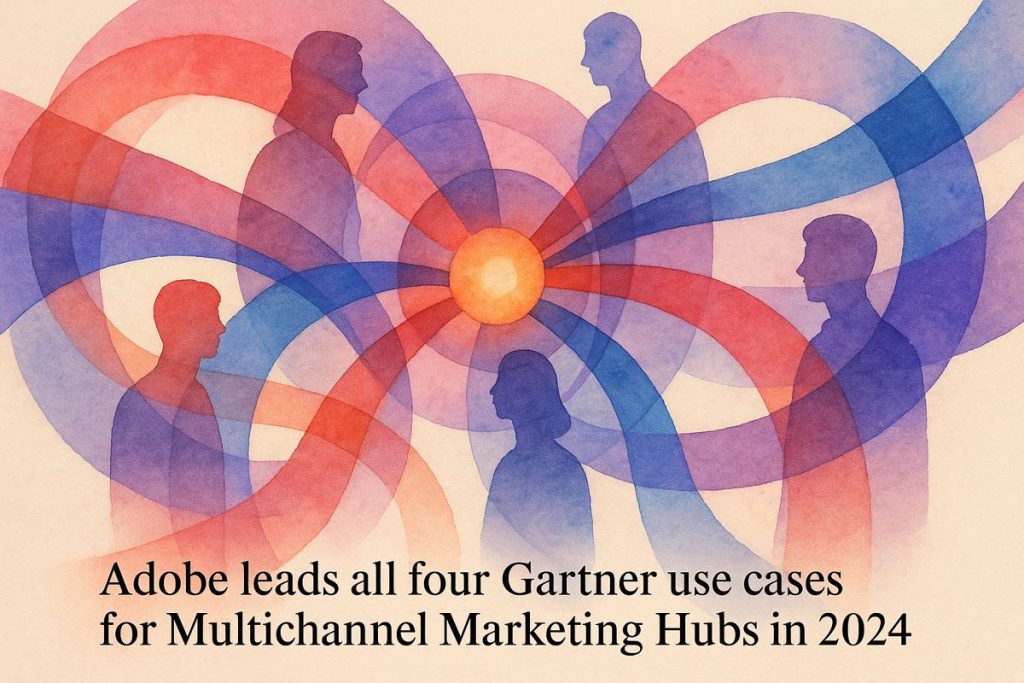Adobe keeps winning in multichannel marketing because it helps brands connect with customers everywhere, all at once, and makes every message feel personal. Its tools work together smoothly, powered by smart AI, so marketers can tweak campaigns on the fly. Gartner’s 2024 report says Adobe is the best at real-time campaign planning, personalized messaging, and bringing all channels together. This makes marketing feel like magic, turning complex customer journeys into seamless, exciting experiences.
Why Does Adobe Consistently Lead in Multichannel Marketing Hubs According to Gartner’s 2024 Report?
Adobe consistently leads in multichannel marketing hubs because it excels in real-time campaign orchestration, seamless integration across platforms, and advanced personalization using AI. Gartner’s 2024 Critical Capabilities report ranked Adobe first in all evaluated use cases, highlighting its innovation, reliability, and comprehensive approach to customer engagement.
The Strange Alchemy of Multichannel Marketing Hubs
There’s a moment, usually around the second cup of coffee, when I stop and ask myself: “Are we orchestrating marketing campaigns, or are we just herding digital cats?” (You’ve been there, right?) In the hyperspectral landscape of customer engagement, multichannel marketing hubs aren’t just software—they’re the nervous system of modern enterprises.
For the uninitiated (or merely groggy), a multichannel marketing hub serves as the conductor for an orchestra of customer touchpoints: web, mobile, social, email, and sometimes the odd carrier pigeon. These platforms coordinate campaigns, track scattered customer journeys, and personalize content at scale. The illusion of seamlessness is hard-won. Ever tried synchronizing a push notification with a direct mail piece? It’s like trying to get Kafka and Hemingway to co-author an email sequence.
But here’s the rub: with each new channel, the customer journey becomes a palimpsest—layered, overwritten, never quite erased. Brands need real-time orchestration. According to Gartner’s 2024 Critical Capabilities for Multichannel Marketing Hubs, Adobe isn’t just keeping up; they’re leading the stampede—again.
Gartner’s Crystal Ball and Its Ripple Effect
If you’ve ever sat in a boardroom while someone waved around a Gartner Magic Quadrant report like it’s the Dead Sea Scrolls, you know these things matter. The Quadrant salutes vision and execution, but the Critical Capabilities report? It’s a microscope, not a telescope—it probes the gritty details that make or break marketing tech out in the wild.
This year, Adobe didn’t just snag a top spot—they ranked first across all four use cases Gartner evaluated. That’s not hyperbole; that’s a sweep. (I double-checked. I once mistook a vendor’s “Leader” badge for an actual Gartner endorsement—never again.) The report’s influence trickles down, shaping procurement decisions at brick-and-mortar stalwarts and cloud-native upstarts alike.
Gartner, with its own quasi-mythic status, forces vendors to show their work. You can’t just slap “next-gen” on a PowerPoint and call it a day. The 2024 analysis looks at everything from real-time analytics to integration prowess, and Adobe earned its laurels—again.
Adobe’s Secret Sauce: Why the Other Kids Can’t Catch Up
Let’s cut through the marketing haze: Why does Adobe, year after year, keep wearing the industry’s heavyweight belt? Partly, it’s relentless R&D—Adobe’s been a Leader for seven years running in the Gartner Magic Quadrant for Multichannel Marketing Hubs. That’s not luck; that’s institutional muscle.
But it’s also the little things. Adobe weaves together tools like Adobe Experience Platform and Sensei AI, so marketers can tweak journeys in real time, sometimes before their third espresso cools. Last fall, they rolled out an AI Assistant—think of it as the Siri for campaign managers, but less likely to misunderstand you at critical moments.
The platforms integrate like a dream (no, really), linking CRMs, commerce clouds, analytics, and content management into something that feels—dare I say—holistic. I once botched a campaign launch because our martech stack didn’t sync. The lesson? Never underestimate the value of seamless integration. Adobe gets it.
And the numbers? Cold comfort for skeptics: Gartner’s 2024 report shows Adobe topping use cases across campaign orchestration, personalized messaging, and real-time decisioning. It’s as if they’re surfing the digital zeitgeist, while others are paddling in the shallows.
From Micro-Stories to Macro-Trends: Why It Matters
I remember a client—a retail chain—who swore up and down that email was dead, while their SMS campaigns thrummed with activity. Turns out, when we analyzed the data with Adobe’s Query Service (SQL compatibility for the win), their best customers still responded to email, but only when it followed a web visit. The sound of that little ding as the dashboard refreshed? Pure delight.
There’s a sensory detail for you: the subtle whir of a server farm spinning up personalized offers, or the tactile click of a dashboard tile revealing—bam!—a hidden trend. That’s the magic. It feels exciting, almost nerve-wracking.
Adobe’s innovations aren’t just shiny baubles. The new Destinations module, for example, lets brands activate data downstream with minimal friction. And the ability to build unified customer profiles—across what can feel like a fractal of digital and physical touchpoints—means marketers can orchestrate not just campaigns, but entire experiences.
It’s not all perfect, of course. Sometimes, the integrations hiccup, or a release note is as cryptic as a Dostoevsky subplot. But the learning sticks: adaptive, data-driven, and ready for whatever marketing’s next season brings.
The Road Ahead: Where the Hub Meets the Highway
So why does all this matter? Because in 2025, personalization isn’t a luxury—it’s table stakes. Multichannel marketing hubs have gone from innovative to indispensable, like Wi-Fi at a marketing conference or the smell of burnt coffee at
